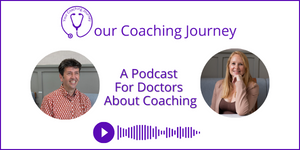Prefer to listen?
This blog post forms the basis of a podcast on our new coaching model, which you can listen to here.
Time to Think Coaching is not an approach that we use in our training. We pull some bits out and utilise them, but it’s not an approach that we teach. We thought we’d share it with you and explore some of the elements that make it unique.
It was devised by Nancy Kline, she’s a bit like the Mary Berry of the coaching world, except that she’s American.
There’s very little to argue with in terms of what she talks about in the coaching space. Tom is quite often heard quoting Nancy Klein saying ‘the mind that contains the problem also contains the solution’ often.
What is it about Time to Think as a coaching approach that makes it different to other coaching approaches?
Firstly, it leaves lots of space. If you think that coaching really originated in organisations, where It’s very much your goal, the current reality? your options? And how are you going to get there? Then, ‘Off you go and do it’. It’s a very much a managerial approach to coaching. Time to Think definitely isn’t. It’s about creating space for someone to think. That’s the whole ethos of it, which is why it’s called time to think.
It’s much more like the person-centred approach to coaching, but it differs slightly.
What Are the Other Key Elements of This Approach?
The Promise that Changes Everything.
‘The Promise that Changes Everything’ in Time to think is that you won’t be interrupted.
By making you this promise, it changes everything.
The Script
This is a very formulaic set of questions that the coach asks their coachee.
Opening with:
“What would you like to think about?”
Then from there, the coach asks
“And what do you think, feel, or want to say?”
The coachee will then talk some more about what they think, feel, or have to say.
Then the next question is,
“And what more do you think, feel, or want to say?”
A very experienced time to think practitioner may just ask the sane questions in a slightly different way. So the emphasis in the first time might be on the thinking “what do you think, feel, I have to say.”
On the second one, it might be, “What do you think, feel, I want to say?
But it’s the same question. It allows the person to continue with their thoughts, to think to the end of their thoughts. When they get to the end you might ask again.
“And what more do you think, feel I have to say?”
This might go on for a while.
The idea is that they think all their thoughts and you’ve exhausted their thinking.
So that’s the point which they ask a different question
“what would you like this session to achieve at this point?”
So they tell you what they want by the end of the session. And then you’d play that back, And then you ask them,
“What are you assuming that’s stopping you from achieving what you’re wanting?”
And then the question that gets asked is,
“What is your positive opposite of the assumption?”
This is a great question to take someone away from the problem, or what they see as the barrier, much like our question that we love, “what would you like to have happen?”
The next question that get asked is labelled as the incisive question:
“If you knew that ‘the positive opposite’, what would you do in order to achieve your goal?
For example, “if you knew that your boss was going to give you a pay rise, what would you do in order to achieve a pay rise?
And that is pretty much it. There’s a bit in the middle about the assumptions that they make where the coach questions whether they it might be a fact. There’s facts, possible facts, and assumptions. As the coach, you’re trying to weed out what is real and what is potentially an assumption.
What Are The Challenges the To Time To Think Approach?
There’s some lovely elements to this approach that we can use. What we find when we’re teaching our coaches is that at the beginning, they rush in and ask another question. It moves quite quickly. But by the time they come to the end of the six months with us, there is lots of lovely space. And this space, this time to think is what is essential and a big plus point of this approach.
However, there are some challenging points:
There’s not a lot of playing back
It’s really hard for someone to see something from a different perspective if they haven’t had that playing back part of the coaching. That’s an essential ingredient in coaching, if you miss it out, you lose so much. Just playing back what you’ve heard can give the person on the other side, real insight from hearing back what it is they’ve been thinking. Unless you’re hearing it coming back, it’s probably very easy to stay in your story and not venture away from what you’re already thinking.
Sometimes coaching is about being heard, but sometimes it is about hearing yourself and saying, ‘Oh, did I really say that?’
That’s where the new thinking starts to appear.
It’s very formulaic
Oftentimes when you’re doing something new, you do want a formula. You want to be told how to do this in a step-by-step approach. But in our training, we make it very clear that we can’t provide a coaching script because everyone is different and every situation is unique. You might take a coaching conversation in one direction and someone else might take exactly the scenario in a different one. Time to Think is a scripted formula.
There’s no space to go in a different direction, or mention that “when you talked about X, your face lit up”. Playing back body language or expressions can be really powerful.
If someone has contradicted themselves, there’s no place to highlight that. It feels like there’s something missing here.
What Options Do You Have?
There’s no option generating or exploration of the options.
Equally, there’s no generating of actions / steps to take.
And people do want to see some progress in their situation.
There are some really great elements of time to think, but if it was the only coaching approach that you had up your sleeve, you would be limiting yourself in terms of what you could do with clients and how you could actually help clients. You are relying on them to do their own perspective taking without offering them any tools, without any exercises that they can do that might give them a different perspective.
As much as we believe people have answers within them, and that we’re making them best of the resources we have available to us, there are always more resources available. When we introduce a tool and exercise, a concept to explore in coaching, that extends our clients’ resources. And this process doesn’t seem to do that.
The premise that Nancy Klein is working on, is that ‘the brain that contains the problem also contains the solution’. That is her offering. If we accept that, then we’re just going to work in this way. However, we belive that some people need a little bit more encouragement for that solution to come out. Not for us to give them the solution, but they need different ways of looking at it in order to draw that solution out.
These are the reasons that we don’t teach this particular approach in its pure form on our course.
We teach the ethos of leaving the space for someone to think. At the point that you think you want to come in and have something to say, pause, hold back and think, is this going to actually contribute? Or am I just best to let them think? Just leaving that a little bit longer, giving them more space.
That’s why we like transformational coaching, because we can take parts of what work from all these different approaches and have them all in our tool box.
Nancy Kline’s book, ‘Time to Think’, or her latest one, ‘The Promise That Changes Everything’, are well worth a read. She has some really interesting things to say. And, if you’ve come from that managerial approach of of coaching, this would change the way that you coach.
But we don’t think this approach is enough, there are lovely elements to it, but also problems with just relying on this as a way to coach.
To find out more about our Doctors’ Transformational Coaching Diploma click through here



